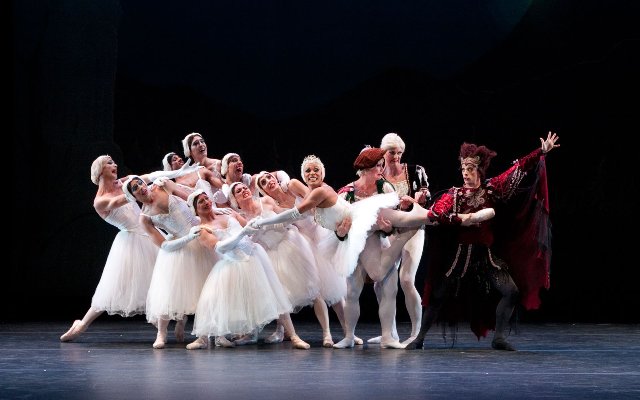Les Ballets Trockadero de Monte Carlo: 50th Anniversary
Gender Bending at Jacob's Pillow
By: Charles Giuliano - Jul 01, 2024
Les Ballets Trockadero de Monte Carlo: 50th Anniversary
Jacob’s Pillow
Ted Shawn Theatre, McCain Stage
June 26-30, 2024
Artistic director, Tory Dorbrin
Executive director, Liz Harler
Associate director, Isabel Martinez Rivera
Ballet master, Raffaele Mora
Production Manager, Shelby Sonnenberg
Le Lac des Cynges (Swan Lake, Act II)|
Choreography, After Lev Ivanovich Ivanov
Music, Pyotr Ilyich Tchaikovsky
Lighting, Kip Marsh
Costumes, Mike Gonzalez
Go For Barocco
Choreography, Peter Anastas
Music, J. S. Bach
Lighting Kip Marsh
The Dying Swan
Choreography, The Trockadero
Music, Camille Saint-Saens
Costume, Mike Gonzalez
Dancer, Olga Supphozova
Paquita
Choreography, after Marius Petipa
Music, Ludwig Minkus
Stage director, Elena Kunikova
Costumes and décor, Mike Gonzales
Lighting. Kip Marsh
Artistic director, Pamela Tatge, opted to launch the 2024 Jacob’s Pillow season with serious fun. During the sold-out performance that we attended of Les Ballets Trockadero de Monte Carlo: 50th Anniversary, raucous hilarity rocked the rafters of Ted Shawn Theatre. Initially he founded the nation’s leading dance festival with an all male company.
So the Trocs, as they are known affectionately, are consistent with the venerable Pillow tradition. There is a long and rich history of males playing female roles from Shakespeare to Kabuki.
The difference is that while that was straight the Trocs perform with tongue-in-chic parody and wit. These gifted, limber and lithe ballerinas perform with a wink and a nod.
As a teenager I saw my first ballet, Swan Lake, performed by Ballet Russe de Monte Carlo, at the former Boston Opera House, since razed, just down from Symphony Hall. I was utterly enchanted and have seen the iconic ballet many times including the Royal Danish Ballet and Sadler Wells in London.
What works so well for the Trocs is that ready familiarity. The audience responds to what they know and anticipate and then the unexpected hilarious riff.
While the disciplined company is utterly flawless the performances are seemingly undermined by pratfalls, and screw ups. The dancers run into and even knock each other over, to the utter delight of the audience.
In their fluid gender reversal these dancers are truly remarkable. They have to master en pointe technique. For women that starts early while we presume the Trocs take this on at mid-career. They have the daunting disciple to parody the entire classical repertory.
There is the obvious challenge of physicality. That is required convincingly to fit into slender costumes and tutus. The impact of the dance is dependent on visual and aesthetic plausibility. Then there is the demand of all those difficult lifts and turns. It must look right before the luxury of spoof.
The entire first act was given over to Part Two of Swan Lake. With sturm und drang to Tchaikovsky’s thunderous score we see the evil wizard (Yuri Smirnov) cast the spell that transforms a queen (Colette Adae) into a swan.Bearing a cross bow Benno ( Tino Xirau-Lopez) is hunting the swan. Humorously, they surround and beat him with a flutter of feathers and a few swift kicks. He is joined by Prince Siegfried (Araf Legupski) who abandons the cross bow when he is quickly smitten by the enchanted swan.
There is the expertly executed pas de deux. He circles her slender waist as she executes a dazzle of turns. She performs the famous solo.
The form demands that the spotlight then turns to him. This is where the great male dancers take to the air with broad, bold leaps.
In dead silence that’s stood on its ear, with exaggerated formality, he progressively moves not by leaps and bounds but by measured steps. The audience responded with humor to the gag.
The prince is determined to rescue the lovely swan. For this he must battle the wizard. In a variation, not in the original, they each yank at an arm/wing of the swan who is at risk of being torn limb-for-limb in a battle of good vs. evil.
After intermission three more pieces followed with parodies of the classical tradition. To music of Bach, in Go for Barocco, we enjoyed a send up of Ballanchine’s formalism.
Three female couples seemed in and out of harmony. There was a lot of catty rivalry as each strove to excel and gobble up adulation. This devolved to throwing kisses to the audience. While taking the dance straight and serious there was great fun when it was run off the rails. Aficionados no doubt reveled in the humor.
The Dying Swan was performed strictly for laughs. The Ballet Russe choreographer, Michel Fokine, initiated what is one the best known dances for the legendary Anna Pavlova in 1905. The piece milks the emotional responses of the audience seeing the death throes of the graceful swan. Here the dancer, Olga Supphozova, literally ruffles her feathers. Her tutu is stuffed with them. Through exaggerated, bathetic last gasps they flutter and clutter the stage. In a desperate last act she gathers them to her bosom, so to speak, before expiring grandly.
After a long pause to clean up the mess and set the stage the curtain parted for the joyously exuberant Paquita. It presented the full company in a work that is rarely performed. It featured the ballerina Varvara Laptopova and Cavalier (Bruno Backpfeifengesicht). Wow, that’s a mouthful. They were accompanied by four individual variations.
There were both exquisitely executed moves as well as the Troc’s signature knocking about. An exiting male dancer clocked a ballerina who struggled to get back in line.
During the curtain call a lady walked on stage with flowers for the leading ballerina. The curtain closed and when it reopened all of the dancers were scrambling to steal the bouquet.
Oh those Trocs, well, boys will be girls.

